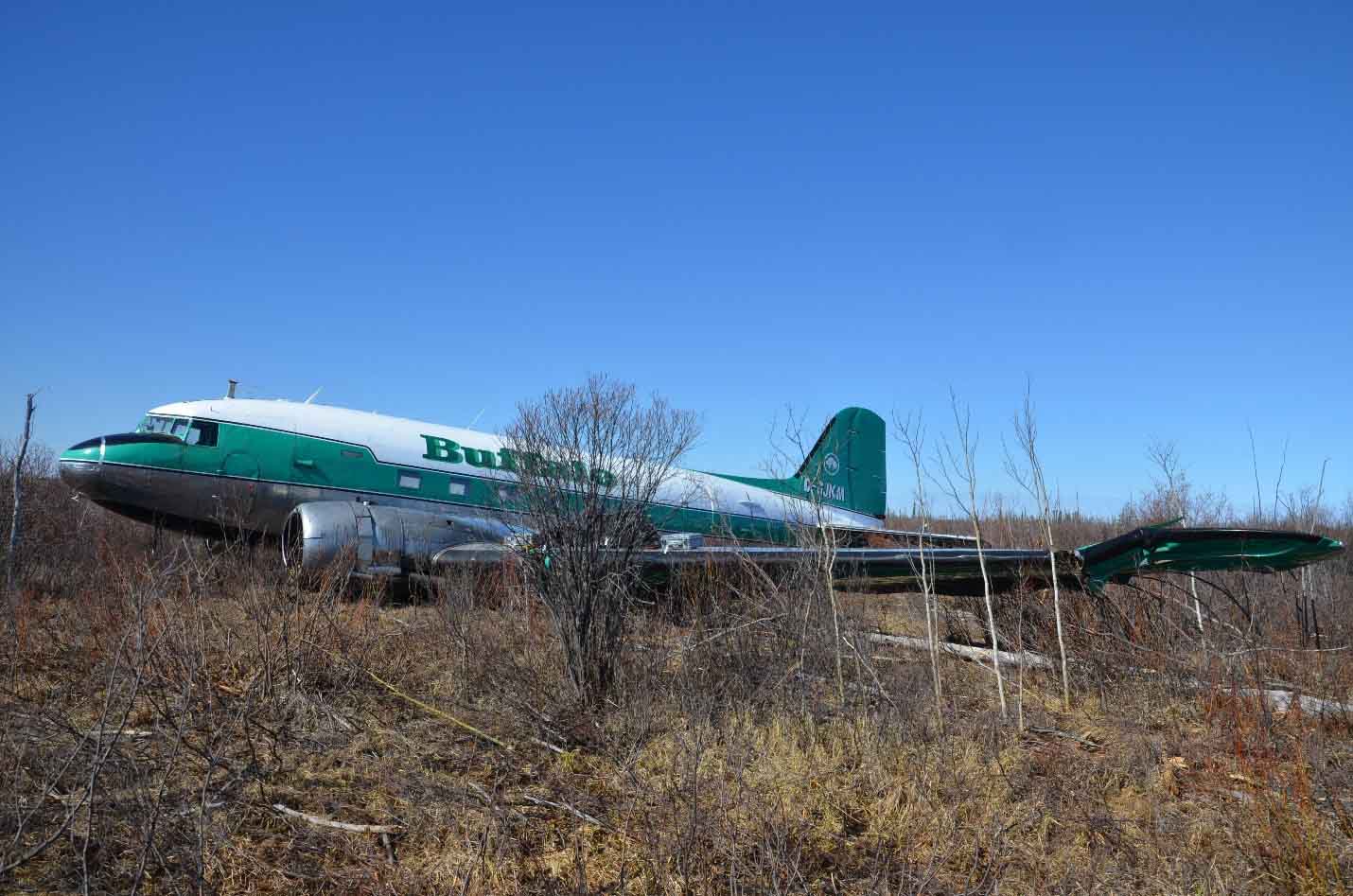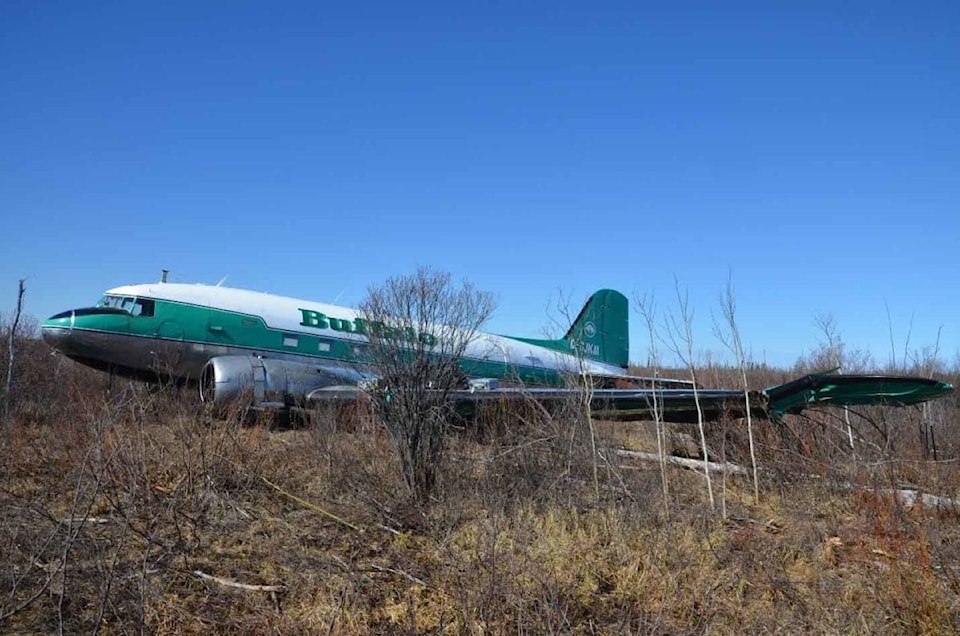
Photo courtesy of the Transportation Safety Board of Canada
A Buffalo Airways DC-3 that crash landed after experiencing engine trouble earlier this year may have been able to make it back to the Hay River Airport except for miscommunication between the pilot and first officer.
That's a key finding in a report released Dec. 20 by the Transportation Safety Board of Canada (TSB) on the May 3 forced landing on the Hay River Reserve.
"In this occurrence, the aircraft's airspeed and altitude could not be maintained, primarily because of the increased drag when the landing gear was extended early in the approach," states the report's safety message, adding the incident highlights the need to follow standard operating procedures and use standard phraseology in an emergency, and the importance of checklist discipline.
The cargo plane – with only the pilot and first officer on board – had just left the Hay River Airport for Yellowknife when it experienced a problem with its left engine and started to lose power.
The TSB report states the first officer observed that the oil pressure was decreasing in the left engine, and moments later, rising cylinder head temperature and oil temperature indications were also observed.
The captain directed the first officer to declare an emergency and request a return to Hay River Airport.
The report notes the aircraft's flight manual does not contain any procedures for abnormal engine indications.
The captain set the left engine to a reduced power setting and increased power for the right engine.
While the aircraft was turning to head back to the airport, smoke and oil were observed, and abnormal sounds were heard coming from the left engine. The flight crew shut down that engine.
The first officer – referred to as FO in the report – then observed zero hydraulic pressure on the landing gear down gauge.
"Thinking this zero pressure was an issue, he mentioned it to the captain, who then directed the FO to 'prep the gear,'" the report states. "The FO extended the landing gear, which the captain did not expect because the aircraft had not started its final approach and the airport had not been visually acquired."
According to the TSB, the direction to 'prep the gear' was a significant factor in the incident.
When contacted by Hay River Hub, Mike Adam, the investigator-in-charge for the TSB, said 'prep the gear' isn't standard terminology to lower landing gear. The typical command is 'landing gear down.'
Asked what the pilot meant by 'prep the gear,' the investigator said the reasoning is not very clear for the misspoken command.
"At the time, the pilot didn't intend for the landing gear to be lowered," said Adam. "Just basically trying to communicate with the first officer to get the gear ready or prepare to lower the landing gear, and that was misinterpreted and as a result the gear came down too early."
Adam said the TSB doesn't know for sure that the plane would have made it back to the airport if the landing gear hadn't been lowered.
"However, it's likely that it would have had a better chance of making the airport had the landing gear not been lowered so early in the approach," he said.
The TSB report states that, after the landing gear was lowered, the aircraft's speed and altitude decreased.
"With the reduced airspeed, the aircraft's flight control response became sluggish and the captain directed the landing gear to be raised," the report reads.
After the landing gear was raised, the flight crew heard abnormal sounds and felt vibrations from the right engine.
"In an attempt to maintain altitude, the right engine was increased to maximum takeoff power, but this had no effect," states the report. "The flight crew then prepared for an emergency gear-up landing, and the aircraft's flaps were lowered on short final to reduce speed for touchdown."
At 8:01 a.m. on May 3, the aircraft landed in muskeg on K'atlodeeche First Nation land, approximately 6.5 km southeast of the Hay River Airport.
The crew was uninjured, but the aircraft received substantial damage.
First responders arrived at the accident site at 11:14 a.m.
The TSB report notes the captain and first officer were certified and qualified for the flight, and had experience in a DC-3.
Buffalo Airways has a Transport Canada-certified crew training program, which includes information on effective communication. Both flight crew members received the training.
Fatigue was not considered a factor in the incident.
The aircraft was certified, equipped and maintained in accordance with existing regulations and approved procedures. The weight and balance were within the prescribed limits.
The report states that the TSB conducted a limited-scope, fact-gathering investigation of the forced landing.
"Due to the limited scope of this investigation, the cause of the oil discharge leading to the left engine being shut down was not determined," it reads. "Similarly, the source of the abnormal sounds the flight crew reported hearing from the right engine was not identified."
Adam said Buffalo Airways will send the engines to a facility to be taken apart and evaluated, and the TSB will be involved in that process.
Buffalo Airways did not respond to a request from The Hub for comment on the TSB report.
The company was grounded in 2015 following a Transport Canada investigation stemming from another DC-3 crash landing at the Yellowknife Airport in 2013. The Hay River-bound passenger plane was forced down just short of the runway when its right engine caught fire shortly after take off.
The TSB is an independent agency that investigates incidents to advance transportation safety. It does not assign fault or determine liability.
